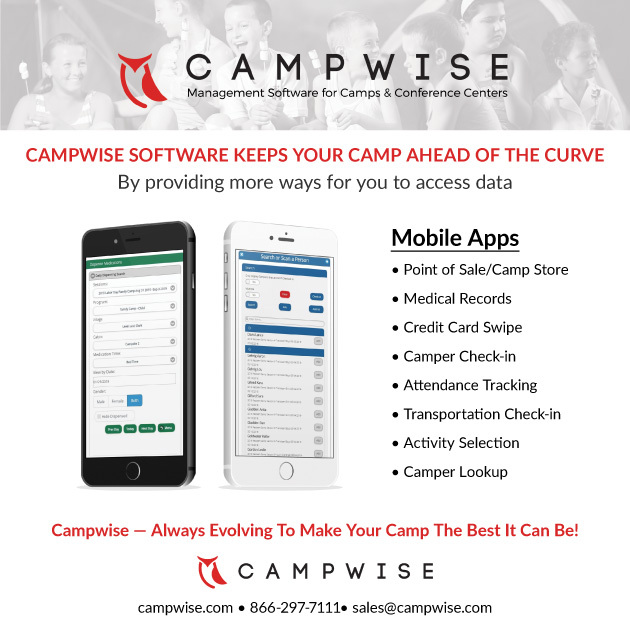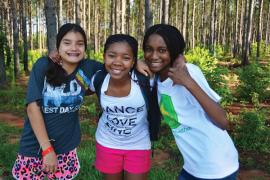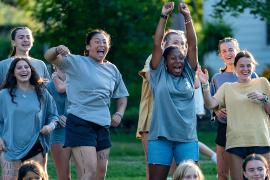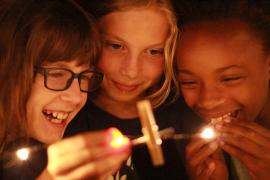The “Surviving and Thriving” theme for this year’s ACA National Conference is one that both acknowledges the challenges that we as a society have triumphantly endured over the last few years and inspires a fruitful future for the camp industry. With this in mind, Briana and I jumped at the opportunity to lead the Camp Includes Me track for the conference and decided to focus on racial and gender equity. The decision to narrow the focus of the Camp Includes Me track this year is in response to recent political events that govern how we navigate society and the prevalence of violence and unveiled discrimination in the media against people due to race and gender.
When I think about surviving and thriving, the first image that pops into my mind is of the underdog. I think about the people who, despite systemic oppression, somehow manage to get up each day and stay motivated by the hope of a better future — a person who is surviving but rarely thriving. In America, more often than not, that underdog is from an underserved neighborhood and belongs to a marginalized community. With just those few details, I can bet that you are probably picturing the same people as me: a poor woman, a gender-fluid adolescent, and possibly a black male in the presence of law enforcement. Throughout history, the media has portrayed these people as the underdog and, sometimes, criminal. But over the last two years the COVID-19 crisis has exacerbated this rhetoric in a way that is forcing all of us to face the racism and sexism embedded in the fabric of American culture that impacts youth in harmful ways.
Summer camp is regarded as a sacred safe place that truly allows children to flourish and grow, despite it being a microcosm of society at large. But in order to achieve this successfully in the future, we must create camps that are constantly thinking critically and processing current events, both political and otherwise. That way we can help campers make sense of the ever-changing world around them. The Camp Includes Me track is intentionally curated to attract camp professionals who have:
. . . figured out ways to navigate the demographic landscape of camp as it continues to shift and to transform to meet the ever-evolving needs of our current and potential campers and staff who may have different ethnic backgrounds, world views, sexual orientations, lifestyles, ages, physical and mental capabilities, religious expressions, economic status, values, and experiences” (Jaha-Echols, 2017).
In 2021, the federal government published an executive order and put together a strategy to address some of the present impacts of systemic oppression and name equity as the goal. In these documents, the comprehensive definition and strategy include both an emphasis on the use of an “intersectional approach that considers the barriers and challenges faced by those who experience intersecting and compounding forms of discrimination and bias related to gender, race, and other factors,” and defines equity as “the consistent and systematic fair, just, and impartial treatment of all individuals, including individuals who belong to underserved communities that have been denied such treatment” (The United States Government, 2021). In the interest of political neutrality, the major takeaway from these documents is that one needs to take an intersectional approach if the goal is to transition a camp into a place that demonstrates equity, embraces diversity, and supports inclusion. The intersectional approach has evolved a lot since Kimberle Crenshaw described the theory in 1989. Intersectionality provides a “lens through which you can see where power comes and collides, where it interlocks and intersects,” but in its more practical form, the intersectional approach converts these ideas “into hands-on tools that advocates and communities can use” (Columbia Law School, 2017). At camp, one example of how this manifests is trauma-informed care.
Trauma-informed care assumes that at some point in life we all experience trauma. This is a safe assumption considering the collective trauma we are currently experiencing, the COVID-19 crisis. In practice, trauma-informed care is:
creating a physically and emotionally safe environment, establishing trust and boundaries, supporting autonomy and choice, creating collaborative relationships and participation opportunities and using a strengths and empowerment-focused perspective to promote resilience. . . and healing (University at Buffalo School of Social Work, 2020).
The impact of adding an intersectional lens toward safety and equity and adopting a camp-wide trauma-informed care approach lowers the risk of retraumatization for the members of your camp community who routinely experience discrimination and trauma because of their racial or gender identity. By honing in on race and gender, we are attempting to make camps a safe space for individuals who have the greatest risks for harm. If we can accomplish this at the conference, we can collectively move from simply surviving to thriving together.
Camp Includes Me Track 2022
The shift to a safer, more inclusive camp industry means that “Something within us has to shift. We have to approach the challenge in a different way to gain a different perspective — bring new ideas to the table and be unafraid to try something new, to fail, and start again” (Jaha-Echols, 2017). The Camp Includes Me track was created by former ACA board member and camp leader Niambi Jaha-Echols to make the experience and needs of the diverse camp population more visible. Every year since, the track accomplishes this goal by uplifting and highlighting the voices of camp professionals whose identities are historically and systematically marginalized. This year’s Camp Includes Me track will follow the same model.
We acknowledge that for many years the track has been a safe space for all conference attendees who belong to or work with a variety of marginalized populations. The pivot to a focus on racial and gender equity is not intended to be exclusionary nor permanent. But at this moment, when people are actively being targeted and harmed due to their race and gender, this pivot is crucial. By highlighting these two topics, the track aims to challenge and coach camp professionals on how to make their camps physically and mentally safer for all. Each session in the track will focus on different tools, techniques, and recommendations (such as the trauma-informed care example previously shared) to help shift our thinking about how we do camp. For the duration of the conference, we will model how to approach equity at camp through an intersectional lens. Until then, here are some recommendations to get you thinking about how you can begin the work at your camp:
- Start with a meaningful land acknowledgement.
Land acknowledgements are a respectful way to recognize Indigenous people as original stewards of the land. To take this practice past performative, recognize the intellectual contributions of Indigenous people to the general knowledge around land stewardship and connection to the natural world. Also recognize the history that impacts the ability for Indigenous people to access their ancestral land. - Use gender-inclusive language.
Gender-inclusive language transcends the limits of the gender binary. By picking words carefully, you can help make all members of your camp community feel equally valued. Take this a step further and reimagine your camp with gender-neutral spaces that provide even more safety and security. - Tell a racially diverse camp narrative.
When you name cabins, develop your programs, plan camp-wide activities or competitions, include racial diversity. One main goal of camp is to prepare campers to be successful, productive members of society, regardless of race, so your camp should reflect the racial diversity in society. This is especially true if your camp population is racially diverse. Remember, representation matters.
Kindling ConnectionsIn lieu of a guest author for this issue, here are some resources that relate to the focus of this year’s Camp Includes Me track:
|
Makela Elvy, M Ed, is an environmental educator and camp enthusiast. She is a co-founder of Smore Melanin — a platform dedicated to providing resources for BIPOC camp professionals. Over the course of her career, Makela has held camp positions ranging from head counselor to summer program director. Her experience includes nature interpretation, curriculum development, and the creation of a 10-week venture program rooted in experiential learning.
References
Borunda, A. (2020, July 29). People of color 3x more likely to live in ‘nature deprived’ US neighborhoods. Science. nationalgeographic.com/science/article/how-nature-deprived-neighborhoods-impact-health-people-of-color
Columbia Law School. (2017, June 8). Kimberlé Crenshaw on Intersectionality, more than two decades later. law.columbia.edu/news/archive/kimberle-crenshaw-intersectionality-more-two-decades-later
Jaha-Echols, N. (2017, January). Camp includes me: Inclusion, fusion, and cross-cultural agility. American Camp Association. ACAcamps.org/resource-library/camping-magazine/camp-includes-me-inclusion-fusion-cross-cultural-agility
Jaha-Echols, N. (2017, September). Camp includes me: Where do we go from here? American Camp Association. ACAcamps.org/resource-library/camping-magazine/camp-includes-me-where-do-we-go-here
The United States Government. (2021, January 21). Executive order on advancing racial equity and support for underserved communities through the Federal Government. The White House. whitehouse.gov/briefing-room/presidential-actions/2021/01/20/executive-order-advancing-racial-equity-and-support-for-underserved-communities-through-the-federal-government/
The United States Government. (2021, October 22). Fact sheet: National strategy on gender equity and equality. The White House. whitehouse.gov/briefing-room/statements-releases/2021/10/22/fact-sheet-national-strategy-on-gender-equity-and-equality/
University at Buffalo School of Social Work - University at Buffalo. (2020, May 1) What is trauma-informed care? socialwork.buffalo.edu/social-research/institutes-centers/institute-on-trauma-and-trauma-informed-care/what-is-trauma-informed-care.html




